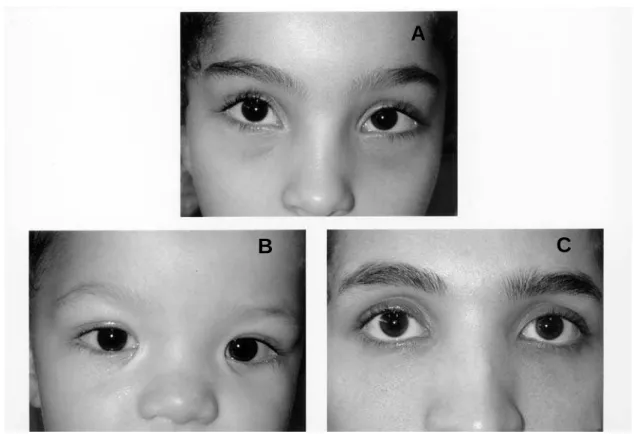459
Aarskog-Scott Syndrome Pediatric Urology – Case Report
International Braz J Urol Vol. 32 (4): 459-461, July - August, 2006
Female Counterpart of Shawl Scrotum in Aarskog-Scott
Syndrome
Suzana G. Moraes, G. Guerra-Junior, A. T. Maciel-Guerra
Institute of Biology and School of Medicine, State University of Campinas, UNICAMP, Campinas,
Sao Paulo, Brazil
ABSTRACT
Aarskog-Scott syndrome (ASS) is an X-linked disorder characterized by facial, skeletal and genital anomalies, including penoscrotal transposition in males. We report on a girl from a family with ASS who exhibits a transposition of the clitoris.
Key words: urogenital abnormalities; FGD1 protein, human; X-linked inheritance; Aarskog-Scott syndrome Int Braz J Urol. 2006; 32: 459-61
INTRODUCTION
Aarskog-Scott syndrome (ASS) is an X-linked disorder caused by mutations in the FGD1 gene (Xp11.21) and characterized by facial, skeletal and genital anomalies (OMIM 305400). The main fea-tures are short stature, ocular hypertelorism, brachy-dactyly, and penoscrotal transposition (shawl scro-tum) in males (1). Female carriers often show some minor manifestations of the disorder, especially in the face and hands. Penoscrotal transposition is a rare abnormality of the external genitalia in which the scro-tum is malpositioned superior to the penis. As far as we are concerned, there are no previous reports on a similar female genital anomaly.
CASE REPORT
The patient, a 5-year-old girl, was evaluated after the diagnosis of ASS in her 17-day-old brother,
who exhibited micropenis. She was born to an 18-year-old woman and her 21-18-year-old unrelated hus-band, and her mother complaint that the girl had no clitoris.
She exhibited ocular hypertelorism (Figure-1), up-slanting palpebral fissures, malar hypoplasia, anteverted nostrils, slight retrognathia, clinodactyly of the fifth fingers and joint hyperextensibility. Genital examination showed labia minora adhesions, and the clitoris was not located in its normal position, i.e., posterior to the anterior labial commissure. Instead, it emerged about 1 cm below (Figure-2).
Her brother had ocular hypertelorism (Fig-ure-1), inner epicanthal folds, prominent ears, malar hypoplasia, small nose, broad nasal bridge, retrognathia, micropenis, bilaterally descended tes-tes, hydrocele and partial penoscrotal transposition (Figure-2), the anus was normally placed.
460
Aarskog-Scott Syndrome
COMMENTS
The etiology of penoscrotal transposition re-mains uncertain (2). Embryological origin of the pe-nis and scrotum are respectively the genital tubercle and labioscrotal folds. At the end of the sixth week of
Figure 1 – Faces showing ocular hypertelorism. A) Index case; B) Brother; C) Mother.
development, males and females have indistinguish-able external genitalia. The penis and scrotum achieve their usual arrangement when, under the influence of androgens, the genital tubercle elongates to become the penis, while migration of labioscrotal folds brings
A
B
C
Figure 2 – A) Abnormal location of the genital tubercle of the index case; B) Normal female external genitalia; C) Partial penoscrotal transposition and micropenis of the patient’s brother.
461
Aarskog-Scott Syndrome
REFERENCES
1. Orrico A, Galli L, Cavaliere ML, Garavelli L, Fryns JP, Crushell E, et al.: Phenotypic and molecular characterisation of the Aarskog-Scott syndrome: a sur-vey of the clinical variability in light of FGD1 muta-tion analysis in 46 patients. Eur J Hum Genet. 2004; 12: 16-23.
2. Pinke LA, Rathbun SR, Husmann DA, Kramer SA: Penoscrotal transposition: review of 53 patients. J Urol. 2001; 166: 1865-8.
3. Moore KL, Persaud TV: The Developing Human: Clini-cally Oriented Embryology. Philadelphia, WB Saunders. 2003.
the latter to a caudal and dorsal position to the penis, where they fuse in the midline (3).
Abnormal location of the genital tubercle or abnormal migration of labioscrotal folds may be the origin of penoscrotal transposition, and may also lead to the abnormal location of the clitoris in the present case. The absence of similar reported cases may de-rive from its rarity, or this may be an under diagnosed feature of ASS. An answer to this question depends on routine evaluation of the external genitalia of fe-male carriers.
CONFLICT OF INTEREST
None declared.
Accepted after revision: December 18, 2005
Correspondence address: Dr. Andréa T. Maciel-Guerra
Dept of Medical Genetics, School of Medicine State University of Campinas
Campinas, SP, 13083-970, Brazil Fax: + 55 19 3788-8909
